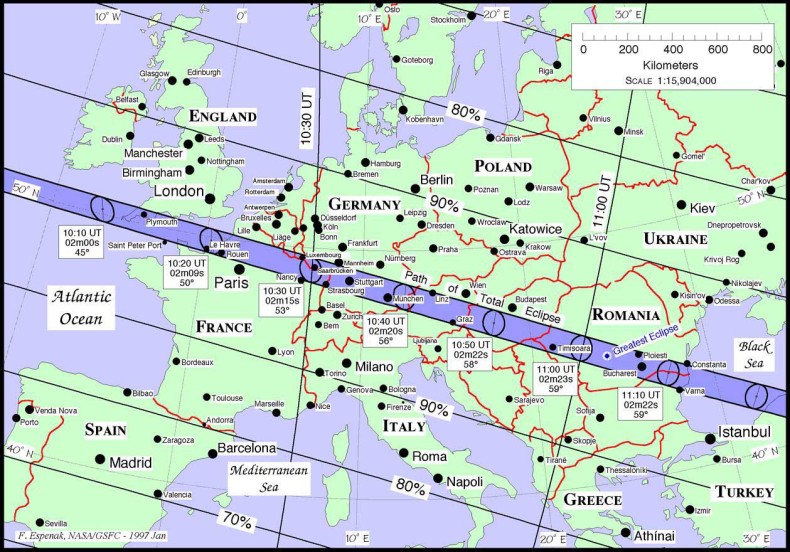
During a total eclipse of the sun, the landscape darkens. But you knew that. What you might not know—what I didn’t know, anyway, when I observed a total solar eclipse on August 11, 1999—is that the experience comes with a lot of other sensory overload.
I found myself thinking about that total eclipse while reading about the one that was visible last month—visible, that is, if you were among the few eyewitnesses in the high northern latitudes of the Atlantic Ocean. In 1999, though, the path of totality cut across the heart of Europe and the abdomen of Asia, ranking it among the most-watched total eclipses of the sun in human history. I myself saw it from the deck of a cruise ship in the Black Sea, courtesy of a magazine that paid all expenses—round-trip air to Athens, cruise passage, ground transportation—in exchange for an 800-word article. (Plus the fee for writing the article.) (Those were the days.) While I clearly remember the sight of the moon’s disk slipping in front of the sun’s—somewhere I have a tape recording of my on-the-scene musings, which, as I recall, consisted mostly of “Wow”s—I also can conjure, just as vividly, memories of what I didn’t expect.
First, the shadow. Of course a solar eclipse comes with a shadow. As a kid, I used to sit on the front porch of my house in Chicago and wait for the shadows of planes landing at O’Hare Airport to skim the grass in the field across the street. How could the moon not shoulder its own shadow? Still, I hadn’t thought to anticipate the onrush of midday darkness, so seeing it barreling toward me across the surface of the sea certainly got my attention.
Then, the temperature. As soon as the edge of the moon belly-bumps the edge of the sun, the weather can turn noticeably cooler. On our ship, idling on open waters on a hot August afternoon, the temperature over the two-plus hours between first contact and totality dropped 21 degrees Fahrenheit, to 83.
Finally, the sounds of wildlife. As the sky darkens, animals will begin to settle down for the night, which in the case of birds means they will stop chirping. Witnesses describe the phenomenon as an eerie silence. I myself can’t speak from experience, since my ship was many dozens of miles from any shore.
The next total eclipse of the sun will occur in 2016 on March 9 (local time) along a path beginning west of Sumatra, continuing eastward through Malaysia, and arcing northward into the Pacific, where the operators of numerous cruise ships are already planning to cut engines and idle. If you should decide to book yourself a berth, just remember: watch for the shadow, wait for the cooling, and listen for the sound of wildlife—not the unnerving absence of birdsong, but the one that interrupted my own reverie: the release, from hundreds of humans staring up, of individual variations on the word “Wow.”
* * *
Image credit: NASA.
Very nice article. I’ve viewed several total solars. (Photos on my website.) However, situated in northern France, I had bad clouds luck in Aug. ’99. Friends a few miles north had a perfect view….which speaks to the fickledness of total solar eclipses! For everybody’s interest, August 21, 2017 a total solar is scheduled to cut diagonally across the US from Oregon to South Carolina. Let’s hope for cloudless skies along the entire path!